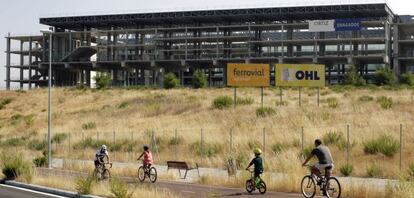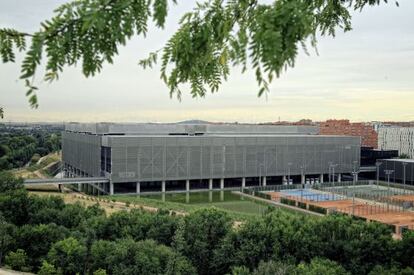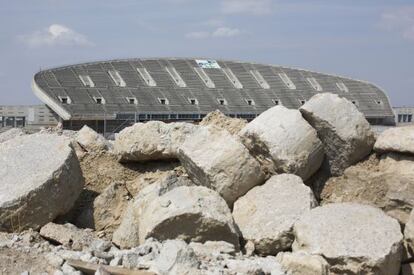The relics of a broken Olympic dream
Madrid needs 1.5 billion euros to complete its infrastructure for the Games After the failure of the city’s bid to host the 2020 event, there is no plan to complete the work

Madrid city council has debts of 7.780 billion euros. And after having crashed out in the first round of voting on Saturday in its bid to host the 2020 Olympic Games, the prospect of an influx of funds has vanished into thin air. The estimated 4.012-billion-euro injection of investment that hosting the 2020 Games would have brought with it would not have allowed the council to pay off its debts, which are the highest among all of Spain’s municipalities. But it would have given Mayor Ana Botella two things: liquidity, and hope in a project that would have mobilized the city and, thus, also voters.
The huge blow of losing the Games to Tokyo leaves the future of numerous half-finished construction projects up in the air, as there is no budget or political plan to see them completed. Finishing, tidying or improving the structures would take an additional 1.5 billion euros. A third was set to come from the central government, a third from the Madrid regional government and the rest from the city council. But after the defeat, there is simply no money – and there are other priorities. The relics of Madrid’s broken Olympic dream will remain there, as silent witnesses of what happened, for a long time: a stadium that’s not even half completed; an aquatics center that is nothing but a pile of concrete; and the Caja Mágica sports arena, which has run up multimillion-euro losses and cannot find a buyer.
The aquatics center. Finishing the project would cost no less than 48 million euros. The center was designed by the architect Juan José Medina, and the initial plan was for it to be complete by spring 2008. After the Games, it was supposed to benefit around 150,000 residents of the San Blas neighborhood. The center was designed to house four swimming pools, and have the most advanced climate-control, renewable-energy and water-treatment systems in the world. But after Madrid lost its bid for the 2016 Olympics to Rio de Janeiro in 2009, the city’s hopes shrank and construction ground to a halt. Now a metal fence surrounds the barren plot from which the framework of the four-story concrete structure rises. The whole of the interior is still to be completed.

La Caja Mágica. The arena where the tennis and basketball events were due to be held has not found a fixed purpose since it opened in 2009, apart from the odd high-level competition, such as the Madrid Masters tennis tournament. Designed by Dominique Perrault, the complex cost 294 million euros – more than double the original budget – and has successively failed in its attempts to serve as the headquarters of the Real Madrid basketball team and the now-defunct HRT Formula 1 team.
The high-quality installation looks to be headed into private hands as a venue for fairs, concerts and other events. The municipal company that manages La Caja Mágica, Madridec, slipped into technical bankruptcy and was dissolved by Madrid Mayor Ana Botella in a desperate attempt to cut spending. The city council is open to selling it, but finding a buyer is proving to be extremely difficult. The price? Around 300 million euros… but that is open to negotiation.
La Peineta. The future looks uncertain for what was the jewel in the crown of the Madrid 2020 bid, the Olympic Stadium in the capital’s northeastern Canillejas neighborhood. The plan for Atlético Madrid soccer club to move from its current home in the Vicente Calderón stadium to La Peineta, which has been beset by one delay after another since the agreement was signed in 2008, now looks in doubt as it will also not be able to rely on any Olympic funds. Construction company Fomento de Construcciones and Contratas (FCC) has committed to finishing the stadium, where Atlético says it will play from 2015. From the deal, the club is set to get a new ground – the ageing Calderón was built in 1966 – and an extra 10,000 seats. The deal would not, however, bring the club in any profits – and that’s despite initial forecasts that it would garner enough cash for the club chiefs to pay off their debts (which amount to 200 million euros with the taxman alone) and leave 80 million euros for new signings.

The project will be financed by the rezoning of the land on which the Calderón and the adjacent former Mahou brewery stands, where almost 2,000 homes and 160,000 square meters of green space will be constructed. All without the city council or the club having to put in a euro: FCC would pay for the work in exchange for developing the Manzanares river development area, including the excavation of the only remaining stretch of the M-30 ring road along the river that is not yet underground. In short, a series of projects that would cost around 270 million euros.
But FCC would have to put in a huge amount of work before it would see any profits. And the company is not in the greatest shape, having recently laid off 200 employees from its headquarters, a full 46 percent of the workers at that division. What’s more, in April the company had to sack 842 people from its construction department.
Tu suscripción se está usando en otro dispositivo
¿Quieres añadir otro usuario a tu suscripción?
Si continúas leyendo en este dispositivo, no se podrá leer en el otro.
FlechaTu suscripción se está usando en otro dispositivo y solo puedes acceder a EL PAÍS desde un dispositivo a la vez.
Si quieres compartir tu cuenta, cambia tu suscripción a la modalidad Premium, así podrás añadir otro usuario. Cada uno accederá con su propia cuenta de email, lo que os permitirá personalizar vuestra experiencia en EL PAÍS.
En el caso de no saber quién está usando tu cuenta, te recomendamos cambiar tu contraseña aquí.
Si decides continuar compartiendo tu cuenta, este mensaje se mostrará en tu dispositivo y en el de la otra persona que está usando tu cuenta de forma indefinida, afectando a tu experiencia de lectura. Puedes consultar aquí los términos y condiciones de la suscripción digital.







































